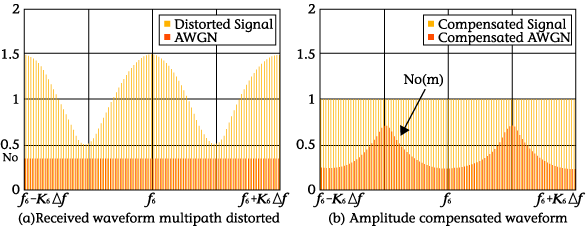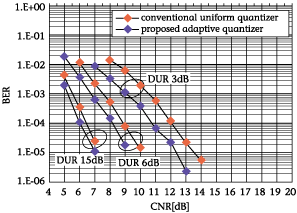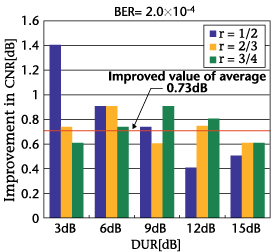Introduction
Digital
terrestrial broadcasting
systems will use
the QPSK-OFDM (Orthogonal
Frequency Division
Modulation) modulation
scheme because of
its robustness in
mobile environments.
This report describes
an adaptive soft
decision Viterbi
decoding technique
of QPSK-OFDM for
multipath fading
channels.
OFDM Signal and
Noise Power Density
When
OFDM is used for
digital terrestrial
broadcasting, special
pilots and guard
intervals are usually
inserted within
the carriers. In
a real environment,
multipath signals
cause ripples to
appear in the transmission
spectrum. However,
if the multipath
signals are within
the guard interval,
almost of all the
original signals
can be recovered
by using the frequency
response of the
pilot signals.
In the case of multi-carrier
OFDM, additive white
Gaussian noise (AWGN)
is evenly distributed
over the transmission
band. However, when
frequency response
characteristics are
used for amplitude
compensation of the
multipath-distorted
signal, the noise
power spectral density
varies with the position
of the carrier. In
Figure 1,  represents the noise
power spectral density
and m the position
of the carrier. However,
in a real environment,
the actual noise power
spectral density cannot
be measured. To solve
this problem, we propose
that an estimate of
represents the noise
power spectral density
and m the position
of the carrier. However,
in a real environment,
the actual noise power
spectral density cannot
be measured. To solve
this problem, we propose
that an estimate of
 be added to the transmission
symbols.
be added to the transmission
symbols.
After extracting the
pilot carriers from
a few symbols, the
pilot carrier set
is transformed with
an Inverse Fast Fourier
Transform (IFFT).
An example of the
transformation is
shown in Figure 2.
It shows that all
the energy is concentrated
in the main lobes.
The noise components
are gotten from the
non-main lobe part
of the time domain
and are used to calculate
the value of  ,
the estimated noise
power spectral density.
We can use the amplitude
compensation to calculate
the noise power spectral
density of each carrier
as ,
the estimated noise
power spectral density.
We can use the amplitude
compensation to calculate
the noise power spectral
density of each carrier
as  ,
where m is
the number of carriers. ,
where m is
the number of carriers.
 |
| Figure 1: Variation of N0
for amplitude compensated OFDM carriers |
 |
| Figure
2: FFT result
for one set
of pilot carriers
(AWGN=24dB) |
Quantization
for Viterbi Soft
Decision Decoding
The use of two-level
quantization is
commonly referred
as "hard-decision"
decoding. When the
quantization level
is greater than
2, the decoding
is called "soft-decision"
decoding.
When the channel
is modeled using
AWGN with a spectral
density of  ,
a 3-bit soft-decision
quantizer has the
best performance
if the decision
metric step size
D is given
by ,
a 3-bit soft-decision
quantizer has the
best performance
if the decision
metric step size
D is given
by  .
Each carrier has
a different noise
spectral density
since each has been
amplitude and phase
compensated. Thus,
the adaptive soft-decision
metric step size
is: D (m)
= .
Each carrier has
a different noise
spectral density
since each has been
amplitude and phase
compensated. Thus,
the adaptive soft-decision
metric step size
is: D (m)
=  . .
Simulation
a. Simulation
Conditions
The transmission
parameters for the
computer simulation
are given in Table
1. The channel frequency
response is estimated
for each carrier
and equalization
is performed. The
pilots provided
for the purpose
of estimating transmission
characteristics
are referred to
as scattered pilots
(SPs) and are inserted
in the signal every
third interval in
the carrier direction
and every fourth
interval in the
time direction.
These SPs are modulated
by BPSK, and their
amplitude is boosted
to 4/3 that of the
QPSK average amplitude.
The multipath condition
and Viterbi decoder
parameters are shown
in Table 2.
Table
1: Transmission
parameters
for
computer
simulation |
| Transmission
Method |
ISDB-T
OFDM |
| Mode |
1 |
| Number
of Segments |
13
|
| Number
of Carriers |
1405
|
| Carrier
Spacing |
3.97
kHz |
| Effective
Symbol Duration |
252
 sec sec |
| Guard
Interval |
1/8
(31.5  sec) sec) |
|
Modulation |
QPSK
|
| Inner
Code |
Punctured
Convolution
Code
Coding
Rates
r = 1/2,
2/3, and
3/4 |
| Interleaving |
Inter-segment
Interleaving |
|
Table
2: Multipath
conditions
and
Viterbi
decoder
parameters |
| Multipath
Delay
Wave |
| Delay
Time |
14.8887  sec sec
|
| D/U
Ratio |
3,6,9,12,15 dB |
| Number
of delayed wave |
1 |
|
| Viterbi
Decoder |
| Number
of Quantized
Levels |
8 (3 bits) |
| Constraint
Length |
7 |
| Memory
Depth |
70 |
|
b. Simulation Results
 |
Figure
3: Result of
adaptive soft-decision
(fixed code
rate of 1/2,
varying D/U
ratios) |
Figure 3 and Figure
4 compare the BER
performances of
convolutional coded
QPSK-OFDM under
multipath conditions
of the adaptive
technique and those
of the conventional
uniform technique.
Figure 3 is the
result for a fixed
convolutional code
rate of 1/2 in which
the D/U (desired/undesired)
signal ratio was
varied from 3 dB
to 15 dB. Figure
4 shows the result
of a fixed D/U ratio
at 3 dB for code
rates of 1/2, 2/3
and 3/4. From the
figures, we can
see that for all
code rates, the
adaptive technique
has the better performance.
Figure 5 shows the
improvement in C/N
(carrier to noise
ratio) that the
adaptive technique
gives compared with
the conventional
uniform quantizer
at the BER of 2.0×10-4.
We can see that
the adaptive technique
can achieve a 0.4~1.4
dB improvement in
C/N characteristics
for the given conditions.

|
 |

|
| Figure 4: Result of adaptive
soft-decision (fixed D/U ratio of 3 dB and varying code rates
1/2, 2/3, and 3/4) |
 |
Figure 5: Improvement
in CNR |
Conclusion
The adaptive soft
decision decoding
technique for OFDM
receivers using
scattered pilots
improves reception
performance under
multipath distortion.
It first estimates
channel noise spectral
density and obtains
the channel frequency
response; then it
calculates the soft
decision metric
step size for each
OFDM carrier. The
results of a computer
simulation revealed
that the soft decision
decoding technique
could significantly
improve characteristics
compared with the
conventional technique,
which employs a
uniform quantizer.
(Yim Zungkon,
KBS (Korean Broadcasting
System) Technical
Research Institute)
|

